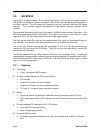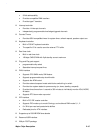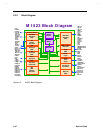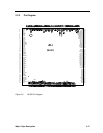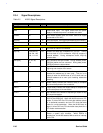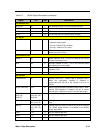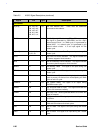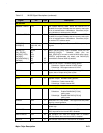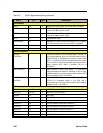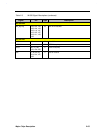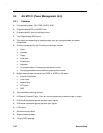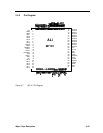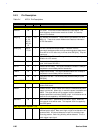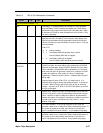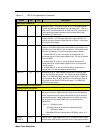
2-22 Service Guide
Table 2-3 M1523 Signal Descriptions (continued)
Signal Pin Type Description
Miscellaneous
MSCLK 154 O Mouse Clock Output when the internal KBC is enabled.
RTC32KI 16 I RTC 32.768K Osc1. This is crystal input and requires an
external 32.768khz quartz crystal.
RTC32KII 15 I RTC 32.768K Osc2. This is crystal input and requires an
external 32.768khz quartz crystal.
SIRQI 44 I Steerable IRQ Input 1
SIRQII/IRQ8J 45 I Steerable IRQ Input 2 when the internal RTC is enabled.
RTC interrupt input when the internal RTC is disabled.
USBCLK 46 I Universal serial bus clock pin (reserved).
USBP1[1:0] 59, 60 I/O Universal serial bus data pin (reserved).
Power Management
EXTSW /
APICREQJ
61 I External SMI Switch or APIC Request Input. EXTSW is a
falling edge triggered input to the M1523 showing that an
external device is requesting the system to enter SMM
mode. An external pull-up should be placed on this signal
if it is not used or it is not guaranteed to be always driven.
When external APIC mode is enabled, this pin is
APICREQJ.
SMIJ / APICCSJ 50 O SMM Interrupt or APIC Chip Select. A synchronous
output asserted by the M1523 in response to one of many
enabled hardware or software events. When external APIC
mode is enabled, this pin is APICCSJ.
STPCLKJ /
APICGNTJ
51 O Stop CPU Clock Request or APIC Grant Output.
STPCLKJ is connected directly to the CPU and is
synchronous with PCI clock. When external APIC mode is
enabled, this pin is APICGNTJ.
IDE Interface
IDRQ[1:0] 138-137 I IDE DRQ Request for IDE Master
IDAKJ[1:0] 143-142 O IDE DACKJ for IDE Master
IDERDY 141 I IDE Ready
IDEIORJ 140 O IDE IORJ Command
IDEIOWJ 139 O IDE IOWJ Command
IDESCS1J 149 O IDE chip Select for Secondary Channel 0
IDESCS3J 150 O IDE chip Select for Secondary Channel 1
IDEPCS1J 147 O IDE chip Select for Primary Channel 0
IDEPCS3J 148 O IDE chip Select for Primary Channel 1
IDE_A[2:0] 145, 144, 146 O IDE ATA Address Bus



